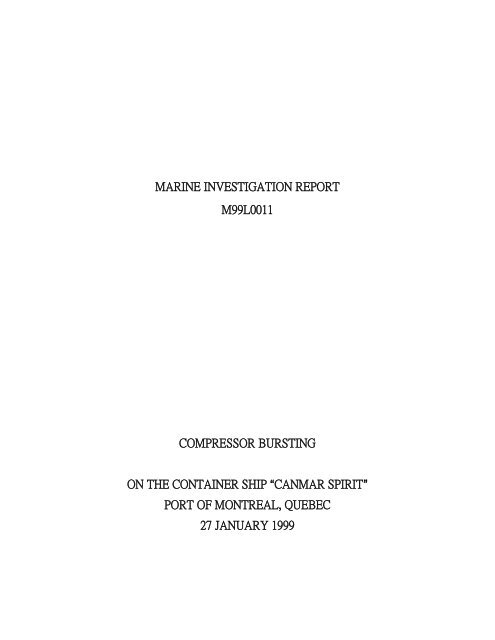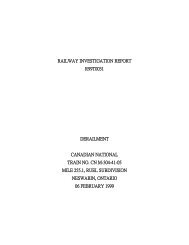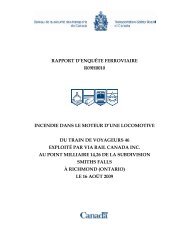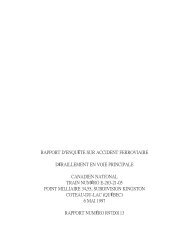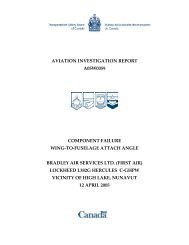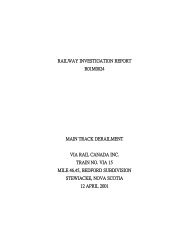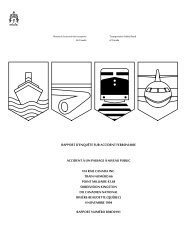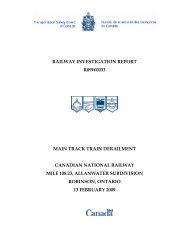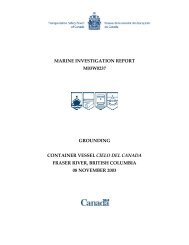marine investigation report m99l0011 compressor bursting
marine investigation report m99l0011 compressor bursting
marine investigation report m99l0011 compressor bursting
You also want an ePaper? Increase the reach of your titles
YUMPU automatically turns print PDFs into web optimized ePapers that Google loves.
MARINE INVESTIGATION REPORT<br />
M99L0011<br />
COMPRESSOR BURSTING<br />
ON THE CONTAINER SHIP ACANMAR SPIRIT@<br />
PORT OF MONTREAL, QUEBEC<br />
27 JANUARY 1999
The Transportation Safety Board of Canada (TSB) investigated this occurrence for the purpose of advancing<br />
transportation safety. It is not the function of the Board to assign fault or determine civil or criminal liability.<br />
Synopsis<br />
Marine Investigation Report<br />
Compressor Bursting<br />
on the Container Ship ACANMAR SPIRIT@<br />
Port of Montreal, Quebec<br />
27 January 1999<br />
Report Number M99L0011<br />
On 27 January 1999, the ACANMAR SPIRIT@ was upbound in the Port of Montreal, Quebec, making way<br />
towards section 78 for berthing and ensuing cargo operations.<br />
As a normal part of the duties during manoeuvring, a member of the engine-room crew was detailed to start two<br />
of the ship=s main air <strong>compressor</strong>s. After having started the No. 1 <strong>compressor</strong> without incident, he proceeded to<br />
initiate the start-up of the No. 3 <strong>compressor</strong>. During the start-up sequence, a sudden and violent<br />
over-pressurization occurred within the <strong>compressor</strong>. Damage to the <strong>compressor</strong> included burst cooler tubes in<br />
the second-stage (after) cooler, burst <strong>compressor</strong> casing in way of the cooling water chamber, and a flayed<br />
flexible delivery air line. The second-stage air cooler cover also burst and fragments of this piece were<br />
projected outward in a shrapnel-like fashion, seriously injuring the crew member.<br />
As the ACANMAR SPIRIT@ had not yet berthed, a harbour tug was used to evacuate the injured crew member<br />
under the supervision and assistance of trained ambulance technicians. The crew member was later pronounced<br />
dead at the hospital.<br />
The Board determined that the No. 3 <strong>compressor</strong> on the ACANMAR SPIRIT@ experienced a severe and near<br />
instantaneous over-pressurization due to the system delivery valve remaining closed while the <strong>compressor</strong> was<br />
started. This omission, combined with the malfunctioning air relief valves, created a closed circuit in which<br />
certain components of the <strong>compressor</strong> could not withstand the ever-increasing pressure. A factor contributing to<br />
the accident was the less-than-adequate maintenance of non-return valves.<br />
Ce rapport est également disponible en français.
Table of Contents<br />
1.0 Factual Information .......................................................................................... 2<br />
1.1 Particulars of the Vessel .............................................................................................................. 2<br />
1.1.1 Description of the Vessel ............................................................................................................ 2<br />
1.2 History of the Voyage ................................................................................................................. 3<br />
1.3 Injuries to Persons ....................................................................................................................... 4<br />
1.3.1 Crew Trauma ............................................................................................................................... 4<br />
1.4 Damage to the Vessel .................................................................................................................. 4<br />
1.5 Certification ................................................................................................................................. 4<br />
1.5.1 Vessel .......................................................................................................................................... 4<br />
1.5.2 Personnel ..................................................................................................................................... 5<br />
1.6 Personnel History ........................................................................................................................ 5<br />
1.7 Laboratory Examination and Testing .......................................................................................... 5<br />
1.7.1 Non-Return Valves and Relief Valves ........................................................................................ 5<br />
1.7.2 Jabsco Water Pump ..................................................................................................................... 6<br />
1.7.3 Second-Stage Air Cooler Cover .................................................................................................. 6<br />
1.7.4 First- and Second-Stage Air Cooler Tubes ................................................................................. 6<br />
1.8 The Compressor .......................................................................................................................... 7<br />
2.0 Analysis ............................................................................................................ 8<br />
2.1 The Compressor System ............................................................................................................. 8<br />
2.1.1 Operational Procedures ............................................................................................................... 8<br />
2.1.2 Start-up Procedure ....................................................................................................................... 8<br />
2.1.3 System Design ............................................................................................................................. 8<br />
2.2 Replacement Parts ....................................................................................................................... 9<br />
2.2.1 Second-Stage Cooler Tubes ........................................................................................................ 9<br />
2.3 Maintenance Issues ..................................................................................................................... 9<br />
2.3.1 Jabsco Pump ................................................................................................................................ 9
2.3.2 Relief Valves ............................................................................................................................... 9<br />
2.3.3 Non-Return Valves .................................................................................................................... 10<br />
2.3.4 Cooler Tubes ............................................................................................................................. 10<br />
2.4 Statutory Regulations and Testing ............................................................................................ 10<br />
2.4.1 Regulations ................................................................................................................................ 10<br />
2.4.2 Testing ....................................................................................................................................... 11<br />
2.5 Crew Rotation ........................................................................................................................... 11<br />
2.6 Post-Occurrence Support ........................................................................................................ 12<br />
3.0 Conclusions .................................................................................................... 13<br />
3.1 Findings ..................................................................................................................................... 13<br />
3.2 Causes ........................................................................................................................................ 14<br />
4.0 Safety Action ................................................................................................. 15<br />
4.1 Action Taken ............................................................................................................................. 15<br />
5.0 Appendices<br />
Appendix A - Photographs ........................................................................................................................... 17<br />
Appendix B - List of Supporting Reports .................................................................................................... 19<br />
Appendix C - Glossary ................................................................................................................................. 20
1.0 Factual Information<br />
1.1 Particulars of the Vessel<br />
Official Number<br />
Port of Registry<br />
Flag<br />
Type<br />
Gross Tons 1<br />
Length<br />
Draught<br />
Built<br />
Propulsion<br />
Cargo<br />
Crew<br />
Passengers<br />
Managers<br />
Owner(s)<br />
1.1.1 Description of the Vessel<br />
- 2 -<br />
ACANMAR SPIRIT@<br />
341333<br />
Hong Kong<br />
Hong Kong (Special Administrative Region/China)<br />
Container Ship<br />
15647<br />
167 m<br />
Forward: 6.46 m Aft: 7.26 m<br />
1970<br />
B&W turbo-charged eight-cylinder diesel engine, 11,100 kW<br />
General cargo in containers<br />
23<br />
None<br />
Split Ship Management Ltd., Croatia<br />
Canada Maritime Ltd., Bermuda<br />
The ACANMAR SPIRIT@ is a 793 twenty-foot equivalent units (TEU) 2<br />
container ship with four holds. The<br />
accommodation and machinery space are located aft. She is a regular caller at the Port of Montreal being on the<br />
North Atlantic trade route between Europe and North America, with an average service speed of 16.5 knots.<br />
Launched in 1971 as the ACP TRADER@, the vessel has seen a number of management and name changes. In<br />
1982 she was renamed AANDES TRADER@, in 1986, ASAN LORENZO@ and in 1994, ACANMAR SPIRIT@.<br />
1.2 History of the Voyage<br />
1<br />
2<br />
Units of measure in this <strong>report</strong> conform to International Maritime Organization standards or, where there<br />
is no such standard, are expressed in the International System of units.<br />
See Glossary at Appendix C for all abbreviations and acronyms.
- 3 -<br />
On the afternoon of 18 January 1999, the ACANMAR SPIRIT@ left Lisbon, Portugal, bound for Montreal. By<br />
the early afternoon of 27 January 1999, after an uneventful ocean passage, the vessel was approaching section<br />
78 in the Port of Montreal to berth and commence cargo operations.<br />
In the engine-room, the crew had been mustered to manoeuvring stations and were going about their various<br />
tasks. The chief engineer was present in the control room with the officer of the watch (OOW). At<br />
approximately 1345 eastern standard time, 3<br />
the duty greaser was detailed to start up main air <strong>compressor</strong>s Nos.<br />
1 and 3. After starting the No. 1 <strong>compressor</strong> without incident, he proceeded to start the No. 3 <strong>compressor</strong>.<br />
Shortly after the initiation of the start-up procedure, at approximately 1400, a sudden and violent<br />
over-pressurization occurred within the <strong>compressor</strong>. An explosion-like noise was heard throughout the vessel<br />
and a white vapour was observed in the vicinity of the <strong>compressor</strong> by the crew members in the control room.<br />
The OOW went immediately to the scene of the accident and saw the duty greaser walking uneasily and then<br />
collapsing close to the No. 1 <strong>compressor</strong>, approximately eight metres from the scene of the accident. It would<br />
appear that the victim was in the process of closing the first- and second-stage purge drain valves when the<br />
over-pressurization occurred. The act of closing the purge drain valves positioned him near and just slightly to<br />
the right of the second-stage air cooler cover. The complete and violent failure of this piece of equipment<br />
during the over-pressurization of the <strong>compressor</strong> caused serious injuries to the duty greaser that later proved to<br />
be fatal.<br />
First aid was administered to the injured crew member where he lay by the ship=s personnel. Montreal Marine<br />
Communications and Traffic Services was advised of the situation and the tug AOCEAN INTREPID@, with<br />
ambulance technicians on board, was called to the scene immediately. By 1418, the ambulance technicians had<br />
boarded the ACANMAR SPIRIT@ by way of the tug and were administering first aid to the victim. At<br />
approximately 1455, the injured crew member was evacuated via the tug ashore, and then to a local hospital<br />
under the supervision and assistance of the ambulance technicians.<br />
Once the injured crew member had been evacuated, the berthing operation of the<br />
ACANMAR SPIRIT@ was successfully completed. Upon arrival at the hospital, the injured crew member was<br />
pronounced dead by the hospital authorities.<br />
3<br />
All times are eastern standard time (coordinated universal time minus five hours) unless otherwise<br />
indicated.
1.3 Injuries to Persons<br />
Fatal<br />
Missing<br />
Serious<br />
Minor/None<br />
Total<br />
Crew<br />
1<br />
-<br />
-<br />
22<br />
23<br />
- 4 -<br />
Passengers<br />
-<br />
-<br />
Others<br />
It has been established that the duty greaser died as a result of injuries sustained from fragments of metal<br />
projected at high velocity. It is most probable that the fragments of metal originated from the second-stage<br />
outlet cover that burst during the over-pressurization of the <strong>compressor</strong>.<br />
1.3.1 Crew Trauma<br />
In the 48 hours after the accident, a plethora of officials including inspectors, investigators, Class surveyors,<br />
police, owner=s and insurance representatives visited the vessel. All had many questions in order to satisfy their<br />
mandates, and the senior officersCparticularly the master and chief engineerCwere heavily solicited. Given the<br />
seriousness of the situation, this was to be expected, but <strong>report</strong>edly increased the stress and anguish already<br />
being suffered by the crew.<br />
1.4 Damage to the Vessel<br />
-<br />
-<br />
-<br />
The No. 3 <strong>compressor</strong>, which is of the non-oil-free, reciprocating, water-cooled type, was damaged beyond<br />
cost-efficient repair. The second-stage air cooler cover was burst and fragments of this piece were projected<br />
outward at high velocity in a shrapnel-like fashion. Other damage to the <strong>compressor</strong> included burst cooler tubes<br />
in the second-stage (after) cooler, burst <strong>compressor</strong> casing in way of the cooling water chamber and a flayed<br />
flexible delivery air line. Of the 33 second-stage cooler tubes, 18 were found to be ruptured.<br />
1.5 Certification<br />
1.5.1 Vessel<br />
The last annual survey of the ACANMAR SPIRIT@ was at Rijeka, Yugoslavia, on 09 September 1998. The<br />
Cargo Ship Safety Construction Certificate was issued at London on 16 August 1996 and was due to expire on<br />
14 May 2001. The Cargo Ship Safety Equipment Certificate was issued at Hong Kong on 11 June 1997 and<br />
was last endorsed at Montreal on 12 June 1998.<br />
-<br />
-<br />
-<br />
-<br />
-<br />
Total<br />
1<br />
-<br />
-<br />
22<br />
23
1.5.2 Personnel<br />
- 5 -<br />
The victim held a certificate of competency to perform the duties of a ship=s greaser issued on 01 October 1996<br />
with the endorsement issued in December 1997. He also held a firefighting certificate, a certificate of ability for<br />
handling lifesaving appliances, and a certificate of search, rescue and survival at sea as per the International<br />
Convention on Standards of Training, Certification and Watchkeeping for Seafarers, 1978.<br />
The chief engineer held a first class engineering certificate issued in 1989. The most recent continued<br />
proficiency endorsement was acquired in 1997.<br />
The master held a master <strong>marine</strong>r certificate issued in 1972. The most recent continued proficiency<br />
endorsement was acquired in 1997.<br />
All of the above certificates were issued by the Ministry of Maritime Affairs, Croatia.<br />
1.6 Personnel History<br />
The duty greaser killed by the burst <strong>compressor</strong> had joined the ACANMAR SPIRIT@ on<br />
09 December 1998, seven weeks before the accident. He had been assigned the 1200 to 1600 watch and was<br />
considered a dependable employee and conversant about engine-room procedures. He had previous experience<br />
operating the <strong>compressor</strong>s and was knowledgeable about the start-up procedures. It was his first tour of duty on<br />
board the ACANMAR SPIRIT@.<br />
The master had been at sea since 1965, and had acted as master on various ships since 1978. He had joined the<br />
ACANMAR SPIRIT@ on 13 January 1999 for the first time.<br />
The chief engineer had been employed in a seafaring capacity since 1977, and as chief on various vessels since<br />
1996. He had joined the vessel on 09 December 1998 for the first time.<br />
1.7 Laboratory Examination and Testing<br />
1.7.1 Non-Return Valves and Relief Valves<br />
All three <strong>compressor</strong>s on board the ACANMAR SPIRIT@ are equipped with non-return (check) valves. The<br />
function of the non-return valve is to prevent the reverse flow of air from the air receiver back to the<br />
<strong>compressor</strong>. Upon examination, it was found that the non-return valve on each of the three <strong>compressor</strong>s was not<br />
functioning correctly, thus allowing high-pressure air to leak back into the <strong>compressor</strong>.<br />
The <strong>compressor</strong>s are also equipped with low- and high-pressure relief valves on the first and second stages<br />
respectively. They are of the plunger and spring variety and are adjusted to open at 10 per cent above their<br />
associated stage operating pressure. Upon examination and testing of the failed <strong>compressor</strong>=s relief valves, it<br />
was found that the second-stage relief valve was completely blocked on the inlet side by burnt oil residues, and<br />
at least 50 per cent blocked on the outlet side by similar residues. In this condition, it is highly unlikely that the<br />
valve would have functioned properly. The first-stage relief valve was damaged during the <strong>compressor</strong> failure
- 6 -<br />
by flying debris and was not tested, but a visual examination showed it to be completely blocked by oily, sooty<br />
residues.<br />
The relief valves from the other two <strong>compressor</strong>s were also examined and tested. Only one first-stage and one<br />
second-stage valve worked as specified, giving an overall failure rate of slightly more that 66 per cent (four out<br />
of six relief valves failed to work properly). The malfunctions are attributable to an oily, sooty build-up.<br />
1.7.2 Jabsco Water Pump<br />
The Jabsco cooling water pump from the failed <strong>compressor</strong>, which supplies water to the first- and second-stage<br />
air cooler cylinder jackets and cylinder heads, was disassembled and examined. Four of the nine impeller vanes<br />
had fractured off, two of which were found jammed between the impeller and the pump housing. A fifth vane<br />
was very close to complete fracture. The vane fracture surfaces were examined under magnification and<br />
revealed an appearance consistent with a failure having occurred through a period of time, and not as a result of<br />
the <strong>compressor</strong> failure.<br />
1.7.3 Second-Stage Air Cooler Cover<br />
The second-stage air cooler cover contains a drain valve, a fusible plug and the high-pressure relief valve. At<br />
the time of the failure, this cover fractured into many pieces that were projected outward at high velocity. An<br />
optical microscope examination revealed fracture surfaces consistent with a brittle mode of failure such as<br />
would be present in an instantaneous overstress. No evidence of pre-cracking was observed.<br />
1.7.4 First- and Second-Stage Air Cooler Tubes<br />
While none of the first-stage cooler tubes had failed, 18 of the 33 tubes that make up the second-stage tube nest<br />
failed in a manner consistent with an over-pressurization. Microscopic examination revealed no evidence of<br />
pre-cracking on the fracture surfaces of the tubes. Also, there was no indication of overheating or any evidence<br />
of combustion as would be expected subsequent to an explosion-type occurrence. The evidence therefore points<br />
to a <strong>bursting</strong>-type occurrence.<br />
Close examination and testing of both first-stage and second-stage air cooler tubes indicate that the first-stage<br />
tubes met manufacturer=s specifications but the second-stage tubes did not. Specifically, the manufacturer<br />
specifies copper tube BS2871 which contains a minimum of<br />
99.85 per cent copper and a wall thickness of 0.91 mm for both first- and second-stage tubes. The composition<br />
of the second-stage tubes installed on the <strong>compressor</strong> was found to be consistent with a UNS C68700 aluminum<br />
brass alloy, with wall thicknesses on average only half that of manufacturer=s specifications.<br />
Furthermore, a close examination of these tubes revealed corrosion pitting that can be attributable to the<br />
absence of anti-oxidant additives in the cooling water.<br />
1.8 The Compressor<br />
The No. 3 <strong>compressor</strong> was a Hamworthy type 2TM63 made in 1976 with a rated capacity of 350 cubic<br />
metres/hour at a pressure of 29.3 bar. This <strong>compressor</strong> was of the non-oil-free, reciprocating, two-stage
water-cooled type. As of the end of December 1998, ship records indicate that the total number of running<br />
hours on the <strong>compressor</strong> was 48,002.<br />
- 7 -
2.0 Analysis<br />
2.1 The Compressor System<br />
2.1.1 Operational Procedures<br />
- 8 -<br />
During the examination and testing of the various components of the failed <strong>compressor</strong> and the two other<br />
<strong>compressor</strong>s, the non-return valves on all three <strong>compressor</strong>s were found to be leaking. This was attributable to<br />
their being blocked by sooty, oily residues. With the non-return valves inoperative, manual intervention was<br />
necessary; in particular, the opening of the individual system delivery valve for the required <strong>compressor</strong> before<br />
start-up and the closing of these same valves subsequent to the termination of <strong>compressor</strong> operation.<br />
2.1.2 Start-up Procedure<br />
An examination of the <strong>compressor</strong> flats area after the accident provided clues as to the actions of the duty<br />
greaser while starting <strong>compressor</strong> No. 3. Most importantly, it was found that the system delivery valve for<br />
<strong>compressor</strong> No. 3 had remained closed during the start-up procedure. It seems likely that the duty greaser forgot<br />
to open this valve at the beginning of the start-up procedure. This oversight was made even though he was<br />
conversant with the start-up procedure, had started the <strong>compressor</strong>s repeatedly on this ship since joining the<br />
vessel, and had just successfully started <strong>compressor</strong> No. 1. The duty greaser quite possibly experienced what<br />
could be described as Amode error.@ This type of error occurs when a situation is falsely classified, and the<br />
resulting actions are inappropriate. This error often occurs when the mode in which the equipment is operating<br />
is not visible, and the information provided to the operator is ambiguous. The system delivery valve remained<br />
in the closed position and this was not visible at the <strong>compressor</strong> itself. This omission was one of the primary<br />
elements leading to the severe over-pressurization of the <strong>compressor</strong>.<br />
2.1.3 System Design<br />
Simply defined, a system is an entity that exists to carry out some purpose. 4<br />
A system is composed of humans,<br />
machine and other things that interact to accomplish a goal. Basic principles of systems design seek to reduce<br />
error by eliminating opportunities for operators to produce error within the system, by making errors visible and<br />
reversible and by mitigating error consequence. Every interaction between the operator and the machine (any<br />
type of physical object) within the system provides an opportunity for human error. For those operator-machine<br />
interfaces that are considered essential, it is imperative that the operator be able to control the machine. In order<br />
to do this, the user must know the state the machine is in and must be able to change that state or effect change.<br />
These two tasks are carried out by means of displays and controls respectively. 5<br />
There was no indication at the<br />
<strong>compressor</strong> that the system delivery valve was still closed. Furthermore, manual intervention could have been<br />
4<br />
5<br />
R. Baily, Human Performance Engineering: A Guide for Systems Designers (Englewood Cliffs, N.J.:<br />
Prentice-Hall, 1982) as cited in Mark S. Sanders and Ernest J. McCormick, Human Factors in<br />
Engineering and Design (New York: McGraw-Hill Book Co., 1987), p. 12.<br />
I.A.R. Galer, ed., Applied Ergonomics Handbook (London: Butterworths & Co. Publishers, 1987).
- 9 -<br />
avoided had the non-return valves been operating as designed and the <strong>compressor</strong>s configured for automatic<br />
operation. Automatic control for air <strong>compressor</strong> is not mandatory on this class of vessel.<br />
2.2 Replacement Parts<br />
2.2.1 Second-Stage Cooler Tubes<br />
After examination and testing of the second-stage cooler tubes, it was determined that these tubes did not meet<br />
manufacturer=s specifications with respect to material, outside diameter and wall thickness. When tubing that<br />
met manufacturer=s specifications was tested to destruction, the burst pressure was found to be 7,000 pounds per<br />
square inch (psi). Similar testing of the second-stage cooler tubes resulted in a burst pressure of 4,000 psi.<br />
While this does not appear to be a direct cause or underlying factor for this accident, it does highlight the fact<br />
that significantly inferior replacement parts were used to renew the second-stage cooler tubes. Past experience<br />
has shown that serious <strong>compressor</strong> accidents have occurred on ships due to the installation of sub-standard<br />
replacement parts.<br />
2.3 Maintenance Issues<br />
2.3.1 Jabsco Pump<br />
Since the fusible plug on the high-pressure delivery cover was in good condition, this would indicate that there<br />
was no overheat condition. It is therefore likely that the pump was still functioning, although most probably at<br />
reduced capacity, at the time of the accident. This element of the <strong>compressor</strong> is not at cause.<br />
2.3.2 Relief Valves<br />
The relief valves were found to be clogged with oily, sooty residues. In all likelihood these residues were due to<br />
the lubricating oil used in the <strong>compressor</strong> migrating past the piston rings and thus present in atomized form in<br />
the compressed air. There was no evidence to indicate that a regular verification of the efficacy and calibration<br />
of the relief valves took place on board the vessel, aside from the statutory inspection once every five years.<br />
These valves are normally calibrated by the manufacturer to open at 10 per cent in excess of the working<br />
pressure of the stage in question. The manufacturer=s recommended maintenance schedule suggests lifting the<br />
water jacket relief valve every three months or after 250 hours of use. There is, however, no mention by the<br />
manufacturer of any verification regime for the air relief valves and no Aon-site@ method available to the crew to<br />
undertake a proper verification of relief valves of this design.<br />
2.3.3 Non-Return Valves<br />
The non-return valves were also found to be clogged with similar oily, sooty residues as were found on the<br />
relief valves. The manufacturer=s recommended maintenance schedule for the non-return valves states that they<br />
must be cleaned and inspected every six months or after 500 hours of use. There was no documentary evidence<br />
to substantiate that the recommended maintenance was undertaken by the ship=s crew. The fact that the<br />
non-return valve on the failed <strong>compressor</strong>, as well as on each of the other two <strong>compressor</strong>s, was not functioning
- 10 -<br />
according to manufacturer=s specifications indicates that such maintenance was most likely not carried out.<br />
Underlying factors in the cause of the accident were the malfunctioning of the non-return valves and the fact<br />
that the <strong>compressor</strong>s were not configured for automatic operation. Because this was the case, a human<br />
intervention and presence was necessary in the area to start the equipment.<br />
2.3.4 Cooler Tubes<br />
Under magnification, the second-stage cooler tubes displayed evidence of corrosion pitting on the outer<br />
surfaces. The tubes had an oxidized appearance and tube thickness was not uniform. It was determined that the<br />
use of anti-oxidants in the cooling water was less than adequate and this contributed to an undue corrosion of<br />
tubes. Although not mentioned in the manufacturer=s manual, the addition of anti-oxidants to the cooling water<br />
is considered consistent with current best practices.<br />
2.4 Statutory Regulations and Testing<br />
2.4.1 Regulations<br />
The ACANMAR SPIRIT@ is a Hong Kong-registered vessel and, as such, subject to Hong Kong maritime safety<br />
legislation. Regulation 27(2)(b) of the Hong Kong Merchant Shipping Regulations (MSR) states that:<br />
Means shall be provided in any such ship to prevent overpressure in any part of any such<br />
compressed air system and, where water jackets or casings of air <strong>compressor</strong>s and coolers might<br />
otherwise be subjected to dangerous overpressure due to leakages into the air pressure parts,<br />
suitable pressure relief arrangements shall be provided.<br />
Furthermore, Regulation 77(1)(a) of the MSR states:<br />
the condition of the ship and its equipment is maintained so as to comply with the relevant<br />
provisions of these regulations.<br />
Canadian regulations concerning compressed air systems, such as Schedule XI of the Marine Machinery<br />
Regulations, state very similar rules as regulation 27(2)(b) of the Hong Kong MSR. This is also consistent with<br />
the International Convention for the Safety of Life at Sea (SOLAS), chapter II-1, regulation 34.1. Additionally,<br />
the Canadian regulations call for periodic general inspections of air <strong>compressor</strong>s and their components not<br />
exceeding five years.<br />
However, neither Canadian nor Hong Kong regulations contain a systematic requirement to have the relief<br />
valves tested and/or re-calibrated. In fact, the Canadian regulations leave it up to the inspector=s discretion to<br />
undertake this verification. Specifically, part IV, division I of Schedule XI states:<br />
For air and refrigeration gas <strong>compressor</strong>s and air driven machinery, where applicable and, in the<br />
opinion of the inspector, practicable, verification that the <strong>compressor</strong>s, air driven machinery,<br />
cooling systems, control, monitoring alarm and safety devices are in correct adjustment and<br />
operational condition.
2.4.2 Testing<br />
- 11 -<br />
Under normal circumstances, the Cargo Ship Safety Construction Certificate is endorsed every year and<br />
re-issued every five years. Integral to this renewal is the inspection of all safety devices such as relief valves.<br />
The Cargo Ship Safety Construction Certificate of the ACANMAR SPIRIT@ was issued in London on 16 August<br />
1996 and it was endorsed at Rejeka, Croatia, on 09 September 1998.<br />
Insofar as the relief valves on the <strong>compressor</strong>s of the ACANMAR SPIRIT@, the survey as completed in 1996<br />
was carried out by an exclusive Lloyd=s Register surveyor. The normal survey requirement is to examine the<br />
<strong>compressor</strong> parts in the stripped down condition and subsequently carry out a running test to verify the safety<br />
devices. In order to respect the intent of the regulations, including SOLAS chapter II-1, regulation 34.1, and<br />
provide means to prevent over-pressure in the <strong>compressor</strong> system, the relief valves must be able to operate as<br />
designed. If, inherent in the design of these valves, there is no means for Class inspectors or ship=s crew to<br />
verify their efficacy while in place on the <strong>compressor</strong>, there should be a requirement to have them tested by a<br />
competent authority and accompanied with a certificate of test at intervals that will guarantee their proper<br />
operation.<br />
2.5 Crew Rotation<br />
An argument can be made that one criterion for a vessel to be operated safely, on a consistent basis, is the<br />
requirement that the crew have in-depth knowledge of the structure and interdependence of various elements<br />
within the system. This in-depth knowledge can only be gained through time spent on the vessel, and this result<br />
is obtained through the use of a consistent core crew for any given vessel.<br />
While the <strong>marine</strong>rs aboard the ACANMAR SPIRIT@ had extensive sea experience, their experience on board<br />
this vessel was limited. The victim had joined the vessel 49 days before the accident and he had no prior work<br />
experience on board the ACANMAR SPIRIT@. It was also the first tour of duty on this particular vessel for both<br />
the master and the chief engineer, although the former had had one tour of duty on a sister ship a few years<br />
previously. Of the seven other engine-room crew members, five were on their first tour of duty on the vessel,<br />
one of whom had previous experience on a sister ship. The remaining two were on their second tour of duty<br />
aboard the ACANMAR SPIRIT@.<br />
While rotating crews are more or less the norm in the <strong>marine</strong> trade today, there are drawbacks associated with<br />
high crew rotation on a particular vessel. A lack of continuity of personnel, especially in management positions<br />
such as that of master and chief engineer, can lead to a reduced leadership role for these officers. Another<br />
negative effect could be a lack of insight respecting the particular needs of the vessel. Crew members, including<br />
senior officers, on the vessel for one tour and then onto another vessel for the next tour tend to Aput out the<br />
fires.@ Long-term preventative maintenance, attention to detail and an intimate knowledge of the particular ship<br />
tend to be less than that for a vessel with a relatively stable crew.<br />
Although the International Convention on Standards of Training, Certification and Watchkeeping for Seafarers,<br />
1978 (STCW) ensures a uniform standard of competence, it only speaks to crew familiarisation in respect to<br />
emergency situations. The STCW does not address the issue of in-depth familiarisation for a particular vessel<br />
nor maintenance issues. Section 10 of the International Safety Management (ISM) Code tries to rectify some of
- 12 -<br />
these shortcomings by introducing the necessity of maintenance standards. Although compliance with the ISM<br />
Code is not mandatory for container ships until 1 July 2002, the ACANMAR SPIRIT@ and its managers were<br />
already in compliance and the ship had been issued a Safety Management Certificate.<br />
2.6 Post-Occurrence Support<br />
Despite the increased demands on the crew following the accident, assistance to deal with stress reaction, shock<br />
or post-traumatic stress disorder was neither requested nor forthcoming. However, there was no other known<br />
incident which resulted from such adverse psychological effects. Section 8 of the ISM Code requires that a<br />
Company=s Safety Management System provide measures to ensure prompt response to accidents, hazards and<br />
emergency situation involving its ships, but does not specifically address psychological post-accident support.<br />
Such support, if in place, would contribute to the well-being of the crew and better assure an individual=s<br />
performance and contribution to safety.
3.0 Conclusions<br />
3.1 Findings<br />
- 13 -<br />
1. The duty greaser started the No. 3 <strong>compressor</strong> without opening the system delivery valve for this<br />
<strong>compressor</strong>.<br />
2. The pressure relief valves on both the first and second stages of the failed <strong>compressor</strong> were blocked<br />
by sooty, oily residues and thus rendered inoperable. On the other two <strong>compressor</strong>s, half of all the<br />
relief valves did not work properly, when tested, due to similar residues.<br />
3. The non-return valves on all three <strong>compressor</strong>s leaked, thus allowing compressed air to return to the<br />
<strong>compressor</strong>s from the air receivers when the <strong>compressor</strong>s were not operating. This created the<br />
necessity for human intervention since the delivery valves had to be opened and closed manually<br />
before and after each <strong>compressor</strong> start and stop sequence.<br />
4. The seat and spring plates of the failed <strong>compressor</strong>=s non-return valve appeared to be in good<br />
condition; however, there was an extensive build-up of oily, sooty residues in the valve. This is the<br />
most probable cause of the leaking condition.<br />
5. The Jabsco water pump had been operating at reduced capacity due to five previously broken<br />
impeller vanes, but no evidence of overheating was observed.<br />
6. The fracture surfaces on the second-stage outlet cover were consistent with an instantaneous failure<br />
with no evidence of pre-cracking or previous repair. The cover fractured into many fragments that<br />
were projected outward at high velocity.<br />
7. The duty greaser sustained fatal injuries from fragments of metal projected out at high velocity.<br />
8. The first-stage cooler tubes were consistent with manufacturer=s specifications in all respects. They<br />
did not fail subsequent to the over-pressurization of the <strong>compressor</strong>.<br />
9. Of the 33 second-stage cooler tubes, 18 failed during the over-pressurization of the <strong>compressor</strong>.<br />
10. The second-stage cooler tubes did not meet manufacturer=s specifications with respect to material,<br />
outside diameter and wall thickness. Wall thickness was found to be, on average, half that of<br />
manufacturer=s specifications.<br />
11. The second-stage cooler tubes showed no evidence of overheating or combustion. The<br />
over-pressurization was most likely due to the <strong>compressor</strong> working against a closed circuit created<br />
by relief valves not operating properly and a closed system delivery valve.<br />
12. The cooler tubes revealed corrosion pitting attributable to the less-than-adequate use of anti-oxidant<br />
additives in the cooling water. This does not seem to be a significant factor in this accident.
- 14 -<br />
13. The <strong>compressor</strong> casing burst open in way of the cooling water chamber due to a severe and near<br />
instantaneous over-pressurization. The cooling water relief valve seems to have been operable but in<br />
all likelihood could not handle the rate of expansion associated with the complete and near<br />
instantaneous failure of the high-pressure cooler tubes at pressures at or above 4,000 psi.<br />
14. The majority of the engine-room crew and the master were experienced <strong>marine</strong>rs but this was their<br />
first tour of duty on board the ACANMAR SPIRIT@.<br />
15. Some of the crew members <strong>report</strong>ed being under pressure and stress following the accident but<br />
relief and assistance were neither requested nor offered.<br />
3.2 Causes<br />
The No. 3 <strong>compressor</strong> on board the ACANMAR SPIRIT@ experienced a severe and near instantaneous<br />
over-pressurization due to the system delivery valve remaining closed while the <strong>compressor</strong> was started. This<br />
omission, combined with the malfunctioning air relief valves, created a closed circuit in which certain<br />
components of the <strong>compressor</strong> could not withstand the ever-increasing pressure. Contributing to the accident<br />
was the less-than-adequate maintenance of non-return valves.
4.0 Safety Action<br />
4.1 Action Taken<br />
- 15 -<br />
Before the vessel was cleared to depart, Transport Canada required that correctly calibrated safety relief valves<br />
be installed on all working <strong>compressor</strong>s.<br />
The flexible high-pressure air delivery line was renewed on <strong>compressor</strong> No. 1.<br />
The company requested that the remaining <strong>compressor</strong>s (1 and 2) be re-certified with a maximum allowable<br />
working pressure of 23 bar, down from 29.3 bar. This was done once it was demonstrated that the performance<br />
requirements were respected concerning main engine activation at this reduced pressure. Permanent indications<br />
as to this new working pressure were installed close to each <strong>compressor</strong> nameplate within 14 days.<br />
New pressure gauges on the remaining <strong>compressor</strong>s were to be installed within 14 days.<br />
Shortly after the accident, the management company issued a safety message to all vessels under its<br />
management informing <strong>marine</strong>rs that the statutory inspection of relief valves and pressure <strong>bursting</strong> devices is no<br />
guarantee of their effectiveness between surveys. Additionally, the message required that all safety devices for<br />
pressurized devices be inventoried, checked for manufacturer=s specifications and sent ashore for examination,<br />
testing and re-calibration if necessary, and be accompanied by a certificate of test. The directive goes on to<br />
specify that annual examination and testing of these devices is considered a minimum. Also, the directive<br />
requires that the planned maintenance system be amended to record the maintenance of safety systems. Other<br />
directives within the safety message include the posting of operating instructions adjacent to pressurized<br />
systems, thorough training of crew members in the use and hazards of such systems, and the testing of pressure<br />
alarms and shutdowns, where installed, at intervals not exceeding three months.<br />
The owners advise that the welfare of crew members affected by any emergency situation must be seriously<br />
considered and intend to account for such mental anguish in their emergency scenario checklists.<br />
Following the accident, Lloyd=s Register issued Technical Report No. 12 in their publication AMarine Bulletin@<br />
which requires Lloyd=s Register surveyors, when surveying air <strong>compressor</strong>s and air receivers, to give particular<br />
attention to all safety devices and, in particular, the correct functioning of relief valves is to be witnessed. The<br />
condition and accuracy of pressure gauges should also be checked. The <strong>report</strong> also urges shipowners and<br />
operators to follow manufacturers= recommendations for the operation of this machinery.<br />
The flag state, Hong Kong, also investigated the occurrence producing similar findings and the following<br />
recommendations:<br />
An information document e.g. Marine Department Notice, should be prepared by the Hong Kong<br />
Marine Department to invite all concerned parties= attention (including local maritime education &<br />
training institutions) towards the proper maintenance of shipboard pressure equipment, particularly<br />
the regular maintenance and testing of its safety devices.
- 16 -<br />
Due to the doubtful shipboard maintenance standard as evidenced in the <strong>investigation</strong>, it is<br />
recommended that Hong Kong Marine Department should conduct a Flag State survey and audit,<br />
both to the company and the vessel ... to assess the safety management system of the ship manager<br />
and the vessel. A copy of the <strong>report</strong> together with a warning letter is to be forwarded to the Chief<br />
Engineer stressing that as a qualified engineering officer, it is his duty to supplement any<br />
shortcomings found in the maintenance program.<br />
A copy of the (Hong Kong) Report is to be forwarded to the shipowner and ship manager informing<br />
them that they should ensure the correct functioning and maintenance of all the pressure equipment<br />
fitted on board their ships. A copy of the Report is to be forwarded to Lloyd=s Register of Shipping<br />
for their information.<br />
A copy of the (Hong Kong) Report is to be forwarded to the <strong>compressor</strong> manufacturer to invite<br />
them to enhance their recommended Maintenance Schedule.<br />
This <strong>report</strong> concludes the Transportation Safety Board=s <strong>investigation</strong> into this occurrence. Consequently, the<br />
Board authorized the release of this <strong>report</strong> on 10 May 2000.
Appendix A - Photographs<br />
- 17 -
- 18 -
- 19 -<br />
Appendix B - List of Supporting Reports<br />
The following TSB Engineering Branch Report was completed:<br />
LP 19/99 - Air Compressor Failure Hamworthy Two-Stage.<br />
This <strong>report</strong> is available upon request from the Transportation Safety Board of Canada.
Appendix C - Glossary<br />
- 20 -<br />
EST eastern standard time<br />
IMO International Maritime Organization<br />
ISM International Safety Management<br />
kW kilowatt(s)<br />
m metre(s)<br />
MCTS Marine Communications and Traffic Services<br />
mm millimetre(s)<br />
MSR Merchant Shipping Regulations<br />
OOW officer of the watch<br />
psi pound(s) per square inch<br />
SI International System (of units)<br />
SOLAS International Convention for the Safety of Life at Sea<br />
STCW International Convention on Standards of Training, Certification and Watchkeeping for<br />
Seafarers, 1978<br />
TEU twenty-foot equivalent units<br />
TSB Transportation Safety Board of Canada<br />
UTC coordinated universal time


